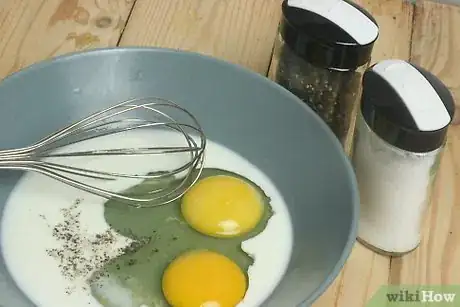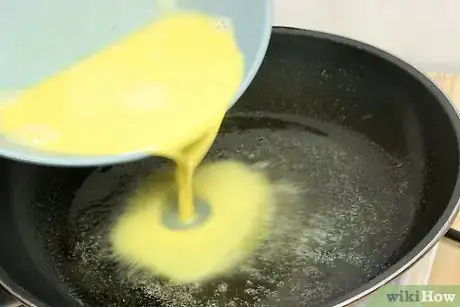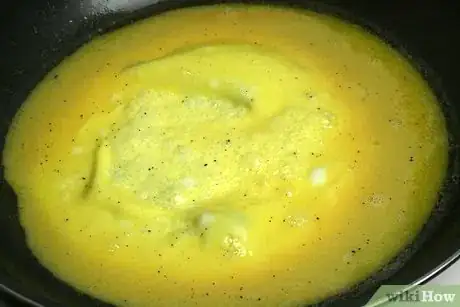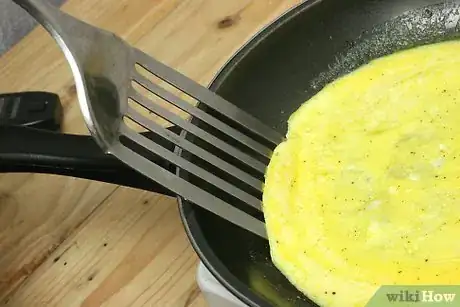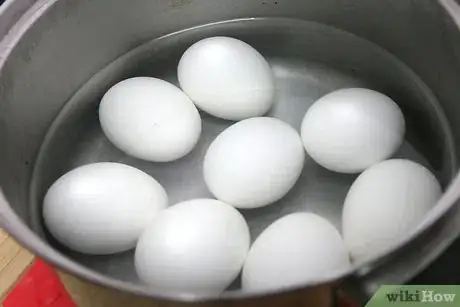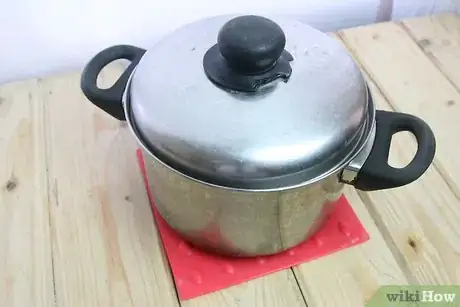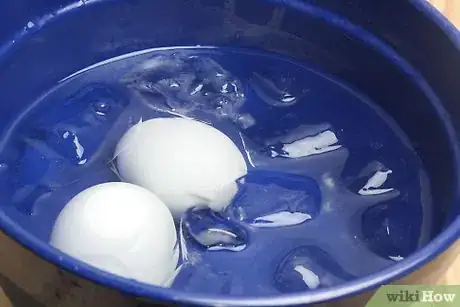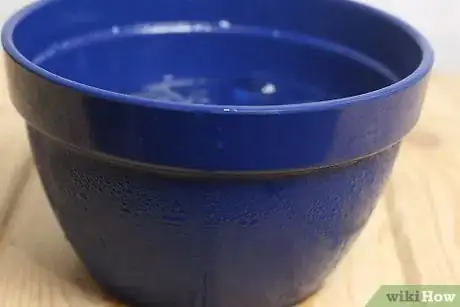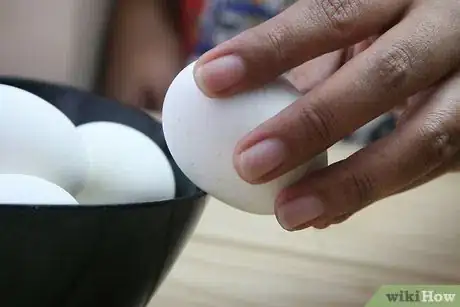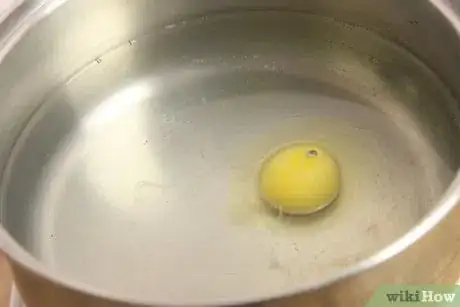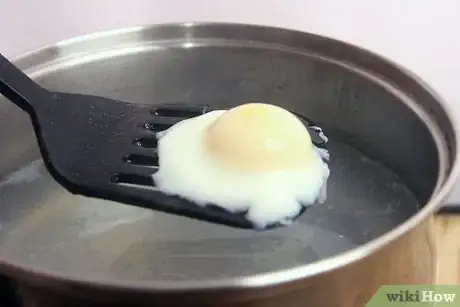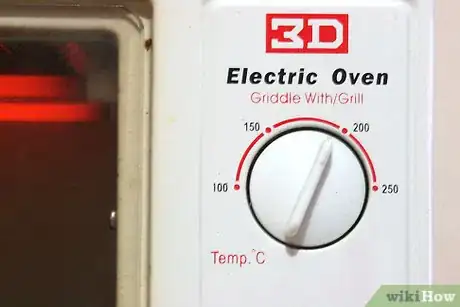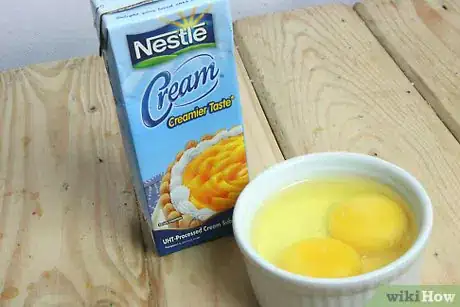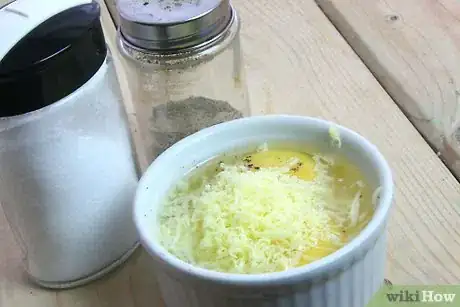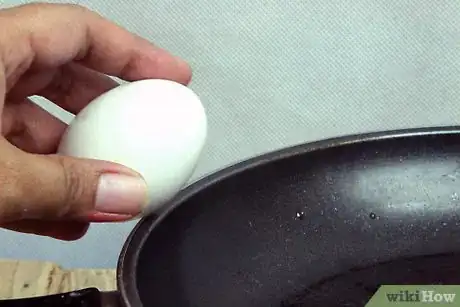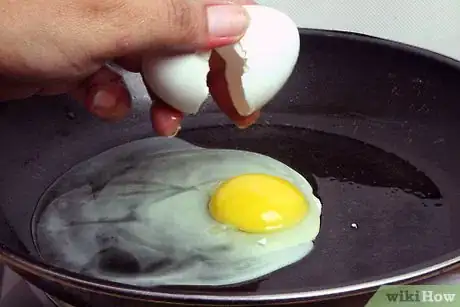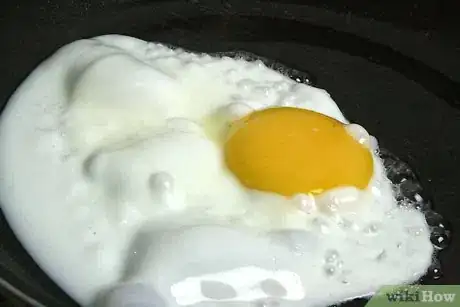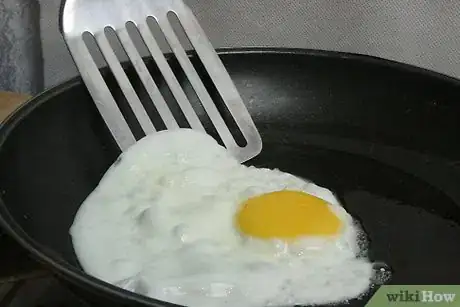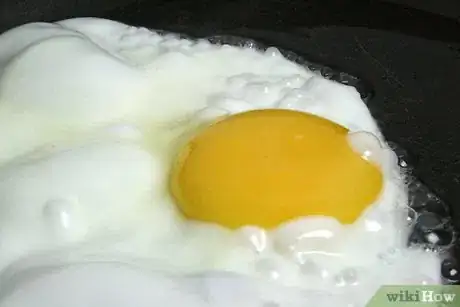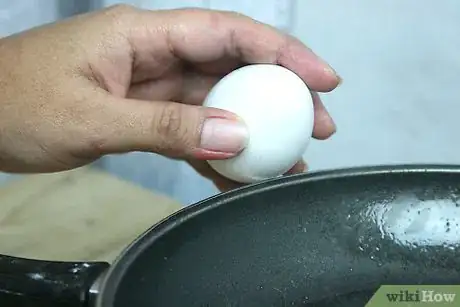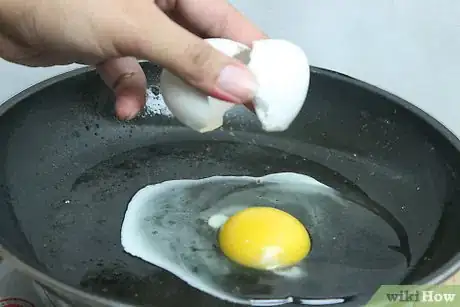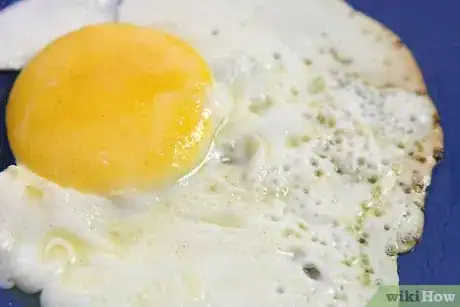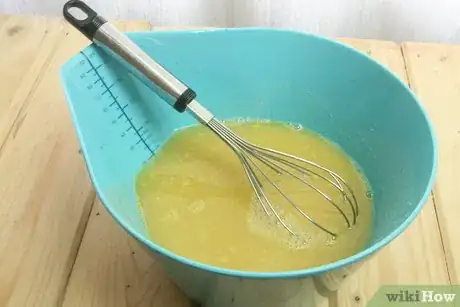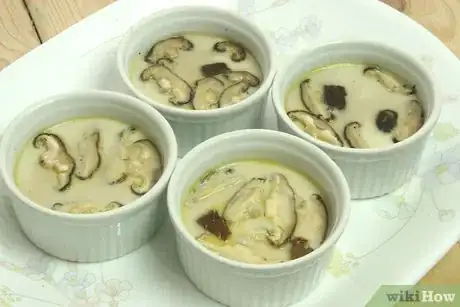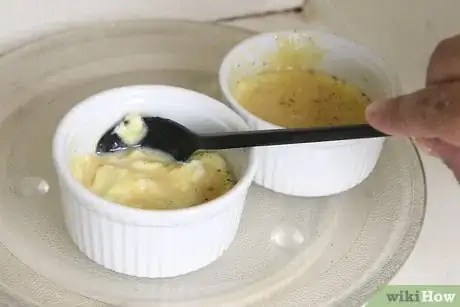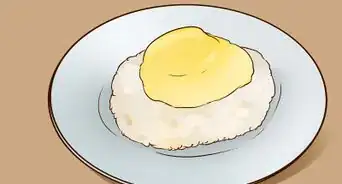wikiHow is a “wiki,” similar to Wikipedia, which means that many of our articles are co-written by multiple authors. To create this article, 30 people, some anonymous, worked to edit and improve it over time.
There are 7 references cited in this article, which can be found at the bottom of the page.
This article has been viewed 121,568 times.
Learn more...
Eggs are packed with protein and are a truly versatile food that can be cooked in many ways. Here are just a few of the most popular methods.
Ingredients
Makes 2 to 4 servings, each
- 4 eggs
- Salt and pepper, to taste
- 1/4 cup (60 ml) milk (optional)
- 4 eggs (room temperature)
- Water
- 4 eggs
- Water
- 1/2 tsp (2.5 ml) butter, softened
- 4 tsp (20 ml) heavy cream
- 4 eggs
- Salt and pepper, to taste.
- 2 tsp (10 ml) grated Parmesan cheese (optional)
- 4 eggs
- 4 eggs
- 4 eggs
- 2 Tbsp (30 ml) butter or cooking oil
- 4 eggs
- 2 cups (500 ml) chicken or fish broth
- 1 tsp (5 ml) soy sauce (optional)
- 1/2 cup (125 ml) sliced mushrooms (optional)
- 2 eggs
- 2 Tbsp (30 ml) milk
- Salt and pepper, to taste
Steps
Scrambled
-
1Spray a medium skillet with cooking spray. Set the skillet on the stove and heat it for several minutes over medium heat.
- Note that you can use 2 tsp (10 ml) of butter or margarine instead of the cooking spray, if desired, but the cooking spray affects the flavor less and makes the dish somewhat healthier.
-
2Whisk together the eggs, milk, salt, and pepper. Crack the eggs into a separate bowl and add the milk, salt, and pepper. Beat well by hand with a wire whisk until all of the ingredients have been combine and the mixture appears mildly frothy.
- The eggs are the only essential ingredient, so you can choose to opt out of the milk, salt, and pepper if desired. Milk creates a richer taste, however.
- If you beat the eggs lightly, the final result will be fairly dense. If you beat the eggs significantly, though, you will beat more air into the mixture and your scrambled eggs will have a lighter texture as a result.[1]
Advertisement -
3Pour the egg mixture into the skillet. Add the beaten eggs to the hot skillet and allow them to cook until they begin to set around the edges.
- Cook the eggs on medium heat to avoid overcooking or burning them.
- Note that the eggs should still look liquidy along the top surface when you prepare to turn them for the first time.
-
4Turn and fold the eggs until thoroughly cooked. Once the eggs begin to set around the edges, use a heat-resistant spatula to carefully pull the eggs toward you, flipping them over so that the bottom portion comes to the top while the liquid underside gets swapped to the bottom.
- Pull the eggs toward you by scraping the spatula beneath them from the side opposite you and dragging the spatula toward you so that the eggs are flipped over.
- Periodically flip the eggs as they cook, resting 20 seconds or so in between each flip. Do not move the eggs around too frequently. Otherwise, they may end up breaking into pieces that are too small and difficult to eat.
- Keep turning the eggs in the pan until all traces of liquid have been removed.
-
5Serve immediately. Scrambled eggs are difficult to store and reheat, so you should enjoy them as soon as they finish cooking.
Boiled
-
1Place eggs in a pot of water. Put your eggs in a medium to large saucepan and fill the pan with enough water to cover the eggs completely.
- Note that the eggs should be at room temperature before you begin to boil them for best results, as this generally prevents eggs from cracking as they boil. You can use cold eggs, but cold eggs are more likely to crack.
- Also note that older eggs are better to boil than fresh eggs. The shell will be easier to remove from the fully cooked egg if you start with an egg that is at least a few days old. The closer the eggs are to their expiration date, the easier it will be to peel them once done.
-
2Bring the water to a boil. Heat the water over medium-high heat until it reaches a rolling boil.
- Salt the water, since doing so will decrease the length of time needed to boil the water.
-
3Turn off the heat and cover the pan. As soon as the water begins to boil, turn the heat off, cover the saucepan, and let the eggs cook in the still-hot water for several minutes until they reach desired doneness. The precise time will vary based on how large your eggs are and whether you want them to be soft-boiled, medium-boiled, or hard-boiled.[2]
- Soft-boiled eggs have a firm white but a runny yolk. Achieve this by cooking medium eggs 4 minutes, large eggs 4 to 5 minutes, and extra large eggs 5 minutes.
- Medium-boiled eggs have a firm white and a semi-firm yolk with some hint of liquid running throughout. Achieve this by cooking medium eggs 5 minutes, large eggs 6 minutes, and extra large eggs 7 to 8 minutes.
- Hard-boiled eggs have a firm white and firm yolk. Achieve this by cooking medium eggs 12 minutes, large eggs 17 minutes, and extra large eggs 19 minutes.
-
4Place the eggs in cold water. As soon as the eggs have finished cooking, remove them from the water with a slotted spoon and dunk them into a bowl of cold ice water.
- Let the eggs sit for at least 10 minutes in the ice water.
- This is not a crucial step, but dunking the eggs in cold water will stop the cooking process and ultimately make it easier for you to peel the eggs.
-
5Peel and enjoy. If eating medium-boiled or hard-boiled eggs, gently crack the shell against a hard surface and use your fingers to peel the shell from the egg white. If eating soft-boiled eggs, slice a portion of the side away and eat the egg out of the shell with a spoon.
Poached
-
1Simmer water in a medium saucepan. Fill a medium saucepan halfway with water and set it to a simmer over medium heat.
- Do not allow the water to reach a full boil.
-
2Break the eggs and lower them into the simmering water.[3] Break each egg one at a time into a ladle or serving spoon and lower the spoon into the pan until it hits the bottom. Slide the egg off so that it sticks to the bottom of the pan. Allow it too cook there for a full 1 minute.
- Add the eggs to the simmering water one at a time.
- You can technically break the eggs directly into the water instead of lowering them in with a spoon or ladle, but breaking the eggs into the water may make it more difficult to control how the eggs turn out.
-
3Loosen and continue cooking. After cooking the eggs on the bottom of the pan for 1 minutes, gently scrape them up from the bottom of the pan using a heat-resistant spatula. Continue cooking for another 3 to 5 minutes.
- The yolk will still be fairly runny once done.
-
4Remove with a slotted spoon and serve. Lift each poached egg from the water, draining away excess water through the slots in the spoon. Enjoy immediately.
Baked or Shirred
-
1Preheat the oven to 325 degrees Fahrenheit (165 degrees Celsius). Meanwhile, prepare two 6-oz (180-ml) ramekins by greasing them with the butter.[4]
- You could spray the ramekins with cooking spray for a lighter alternative, if desired.
- If you do not have ramekins, you can use any small oven-safe cooking dish of similar size. A jumbo muffin pan should work, for instance.
-
2Add the cream and eggs to the ramekins. Pour the cream into the ramekin first. Gently crack the eggshell on the side of the dish and drop the egg directly onto the cream.
- Do not break the yolk and do not stir the egg and cream together.
- Note that each ramekin should contain half the cream and two of the four eggs.
- For presentation purposes, use a dinner spoon to carefully shift the yolks to the center of the dish.
-
3Sprinkle the eggs with salt, pepper, and cheese. Lightly sprinkle these seasonings over the eggs in the ramekins but do not mix or stir them in.
-
4Bake 12 to 15 minutes. Place the eggs in your preheated oven and cook until the whites are set. Note that the yolks should still be soft, though.
-
5Let set for 2 to 3 minutes before serving. Remove the eggs from the oven and allow the to sit out briefly so that the internal temperature drops and the cooking process halts.
Sunny-Side Up
-
1Spray a frying pan with nonstick cooking spray. Set the frying pan on the stove over medium to medium-high heat and wait several minutes for it to get hot.
- Ideally, the pan should be hot enough so that a drop of water immediately sizzles away into steam if dropped inside.
-
2
-
3Cook the eggs until the whites set. This should take about 3 minutes.[5]
- You should not flip, turn, or otherwise move the egg during the cooking process.
- The yolks should be left in liquid form.
-
4Enjoy. Use a spatula to gently lift the egg out of the frying pan and onto your serving plate. Work carefully to prevent the yolk from bursting open.
Over-Easy
-
1Coat a frying pan with nonstick cooking spray. Heat the pan on the stove over medium to medium-high heat.
- Give the pan several minutes to become sufficiently hot. To check the temperature, sprinkle a small amount of water into the pan. If the water immediately sizzles once it comes into contact with the pan, your pan is hot enough.
-
2
-
3Let the whites set on one side. After 2 or 3 minutes, the egg whites should be completely set on the bottom and mostly set on the top.
- Note that the yolk will still be runny.
- Note that the yolk will still be runny.
-
4Flip each egg and continue cooking. Gently slide a spatula under your egg and flip the egg over so that the yolk is now on the bottom. Let cook for another 1 or 2 minutes, or until the yolk is set.
- This must be done very carefully so that the yolk does not break as you flip it. Even if the yolk does break, however, the egg will still be edible, even though it may not look visually impressive.
-
5Serve. Gently slide the egg out of the frying pan and onto your serving plate using a spatula.
Basted
-
1Pour 2 Tbsp (30 ml) butter or cooking oil into a frying pan. Heat the pan on the stove over medium to medium-high heat.
- The butter should be completely melted. If using cooking oil instead of butter, wait until the oil becomes glossier and easier to maneuver around the pan.
- Note that nonstick cooking spray will not work with this method.
-
2Break each egg into the pan. Gently crack each egg on the counter or on the side of your pan and break it directly into the hot oil or butter.
- Cook one egg at a time to prevent the whites from running together.
- Drop the eggs carefully so that the yolks do not break.
-
3Let the egg whites set. Let the eggs cook for 2 to 3 minutes or until the egg whites have completely set on the bottom and are mostly set on the top.
- The egg yolk will still be liquidy.
-
4Pour hot oil over the egg and cook slightly. Carefully use a spoon to remove some of the hot butter or oil from the pan. Drizzle this hot butter or oil over the top of the egg and let the egg cook for an additional 1 minute or so.
- The egg yolk of each egg will be partially set, but not completely solid.
-
5Enjoy. Gently slide the egg out of the frying pan with a spatula and transfer to a serving plate. Enjoy immediately.
Steamed
-
1Whisk eggs with broth and soy sauce. Crack the eggs into a medium bowl and beat them gently by hand using a wire whisk. Gradually add the stock and soy sauce as you whisk the eggs to combine them.
-
2Divide the mushrooms into four ramekins. Evenly distribute your mushrooms into four separate ramekins.
- Shiitake mushrooms are the most traditional, but you can substitute them for your favorite mushroom or a more accessible one if desired.
- You can also add up to 1 cup (250 ml) chopped cooked chicken broth or seafood, if desired.
-
3Pour the egg mixture into each cup. Pour an even amount of the egg mixture over the mushrooms in your ramekins until each ramekin is filled.
- The ramekins should be filled anywhere between 1/2 to 3/4 high.
-
4Boil 1 inch (2 1/2 cm) of water in a steamer. As soon as the water reaches a boil, reduce the heat to a simmer.
- Note that a heavy saucepan with deep sides will work in the absence of a steamer.
-
5Place the ramekins in your steamer. Transfer the ramekins to the steamer, arranging them in a single, even layer. Cover and let cook for 12 minutes.[6]
- If you have a steamer tray, place the ramekins on the tray to keep them out of the water. If not, they may be placed in the water as long as the water does not threaten to overflow into the dish.
- When done, the eggs should have a firm but silky texture slightly reminiscent of tofu.
-
6Serve. Lift the ramekins out of the steamer and enjoy immediately.
Microwaved Scrambled Eggs
-
1
-
2Microwave for 45 seconds on high.[7] The eggs should begin to form large curds.
- Stir the eggs so that the solid portions and liquid portions swap places.
-
3Microwave another 30 to 45 seconds. The eggs should be set or near set once you finish microwaving them.
- Cook for 30 seconds first. If the eggs do not seem solid enough, cook for the additional 15 seconds.
- Cook for 30 seconds first. If the eggs do not seem solid enough, cook for the additional 15 seconds.
-
4Enjoy immediately. Scrambled eggs do not store or keep well, even when made in the microwave, so you should enjoy them immediately.
-
5Finished.
Community Q&A
-
QuestionWhen hard boiling eggs, can I leave them in the cold water for 5 minutes, or does it have to be exactly 10?
 Anony123abcCommunity AnswerIt does not have to be exactly 10 minutes, but if you take them out at the 5-minute mark, you may find that you have difficulty peeling the eggs because they may be hot still. I usually leave mine in for no more than 7 minutes, because they are usually still nice and hot at that time.
Anony123abcCommunity AnswerIt does not have to be exactly 10 minutes, but if you take them out at the 5-minute mark, you may find that you have difficulty peeling the eggs because they may be hot still. I usually leave mine in for no more than 7 minutes, because they are usually still nice and hot at that time. -
QuestionWhat is going to happen if the egg white breaks?
 LesbianUnicornCommunity AnswerThe white won't break. The yolk can, and then yellow liquid will come out. It will be fine though.
LesbianUnicornCommunity AnswerThe white won't break. The yolk can, and then yellow liquid will come out. It will be fine though.
Things You'll Need
- Frying pan
- Heat-resistant spatula
- Nonstick cooking spray
- Saucepan
- Ladle
- Slotted spoon
- 6-oz (180-ml) ramekins
- Dinner spoon
- Mixing bowl
- Steamer
- Microwave-safe dish
References
- ↑ http://www.incredibleegg.org/recipes/recipe/basic-scrambled-eggs
- ↑ http://whatscookingamerica.net/Eggs/BoiledEggs.htm
- ↑ http://www.allyou.com/food/family-meals/cooked-eggs-00411000076270/page19.html
- ↑ http://allrecipes.com/recipe/shirred-eggs/
- ↑ https://panlasangpinoy.com/10-ways-to-cook-an-egg/
- ↑ http://allrecipes.com/Recipe/steamed-egg-chawan-mushi/detail.aspx
- ↑ http://www.incredibleegg.org/recipes-and-more/cooking-school/microwave-scramble-eggs
About This Article
To cook scrambled eggs, first whisk together eggs, milk, salt and pepper. Then, pour the mixture into a medium-hot skillet. When your eggs have started to set around the edges, use a spatula to flip them over, and continue cooking them until they’re solid. Alternatively, you can make fried eggs by cracking them into a medium-hot skillet and cooking them for about 3 minutes, or until the egg whites have set. Take your eggs off the stove immediately if you like them sunny-side up. If you prefer your eggs over easy, flip them and cook them for another 1-2 minutes to set the yolks. To learn how to boil or poach your eggs, or how to make scrambled eggs in the microwave, read on!

